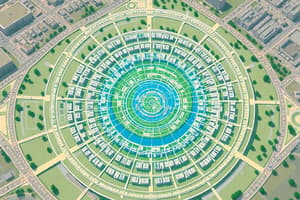Podcast
Questions and Answers
Which factor influences settlements through their physical geography?
Which factor influences settlements through their physical geography?
- Change
- Function
- Shape
- Site (correct)
What is the main reason modern-day settlement patterns are changing?
What is the main reason modern-day settlement patterns are changing?
- Language barriers
- Social media influence
- Traditional beliefs
- Technological developments (correct)
Which type of settlement usually has a lower population density and smaller settled areas?
Which type of settlement usually has a lower population density and smaller settled areas?
- Urban towns
- Rural towns (correct)
- Megacities
- Conurbations
What defines the range of settlement patterns from isolated buildings to megacities?
What defines the range of settlement patterns from isolated buildings to megacities?
In what type of settlement are people likely to experience urban sprawl?
In what type of settlement are people likely to experience urban sprawl?
What characterizes settlements that are usually densely populated over a smaller area?
What characterizes settlements that are usually densely populated over a smaller area?
Which of the following is NOT a common reason for the development of nucleated settlements?
Which of the following is NOT a common reason for the development of nucleated settlements?
Which type of settlement pattern is characterized by isolated houses or farms set in fields or along roads, rather than concentrated in one area?
Which type of settlement pattern is characterized by isolated houses or farms set in fields or along roads, rather than concentrated in one area?
What is the key feature that distinguishes a cruciform settlement pattern from a cross-shaped settlement pattern?
What is the key feature that distinguishes a cruciform settlement pattern from a cross-shaped settlement pattern?
Which of the following is NOT a common type of settlement pattern described in the text?
Which of the following is NOT a common type of settlement pattern described in the text?
What is the key feature that distinguishes a linear settlement pattern from a nucleated settlement pattern?
What is the key feature that distinguishes a linear settlement pattern from a nucleated settlement pattern?
Flashcards are hidden until you start studying
Study Notes
Settlement Patterns
- A settlement is a place where people live and carry out various activities, such as trade, manufacturing, and agriculture.
- Settlements can be categorized based on their pattern, shape, site, situation, function, and hierarchy.
Factors Influencing Settlements
- Population change, technological developments, changing lifestyles, and expanding urban limits affect modern-day settlement patterns.
- The rise of megacities and urban sprawl contributes to changes in settlement patterns.
Settlement Patterns
- Settlements come in different shapes and sizes, ranging from isolated buildings in rural regions to urban megacities.
- Urban areas, such as towns, cities, conurbations, and megacities, are typically densely populated over a smaller area.
- Rural towns and fringe areas are densely populated over a larger area.
- Villages and hamlets have a lower population density and smaller settled areas.
Physical Geography and Settlement Patterns
- The physical geography of an area dictates settlement patterns.
Form or Shape of Settlements
- The form or shape of a settlement refers to its layout.
- Linear settlements develop along a physical feature, such as a river, railway, or major road, to attract trade.
- Circular settlements grow around a central feature, like a village green or lake, and are organized to maintain accessibility.
- Star-form settlements occur when several roads meet, and houses are built along those roads.
- T-form settlements arise when one road meets another at a junction.
- Y-form settlements develop where two roads meet, and houses are built along those routes.
- Cruciform settlements occur at crossroads, and houses cluster and spread in all directions.
Dispersed Settlements
- Dispersed settlements consist of isolated houses or farms set in fields or along roads, rather than concentrated in one area.
- They are found in sparsely populated rural areas, such as the Sahel region of Africa, the Australian outback, or mountainous regions of Scotland and Wales.
- The break-up of large rural estates led to dispersed settlements in England during the 16th and 17th centuries.
- Dispersed settlements also occur where the physical geography is extreme, discouraging settlement and development.
Linear Settlements
- Linear settlements form when settlements group and form a line along a physical feature, such as a river or a trade and transport route.
Nucleated Settlements
- Nucleated settlements form when settlements tightly cluster around a central feature, such as a village green, a crossroad, or a church.
- They are usually called hamlets or villages, depending on their size and function.
- Nucleated settlements develop due to defence, trade, co-operative community, agriculture, water, work, or floodplain safety reasons.
Studying That Suits You
Use AI to generate personalized quizzes and flashcards to suit your learning preferences.




